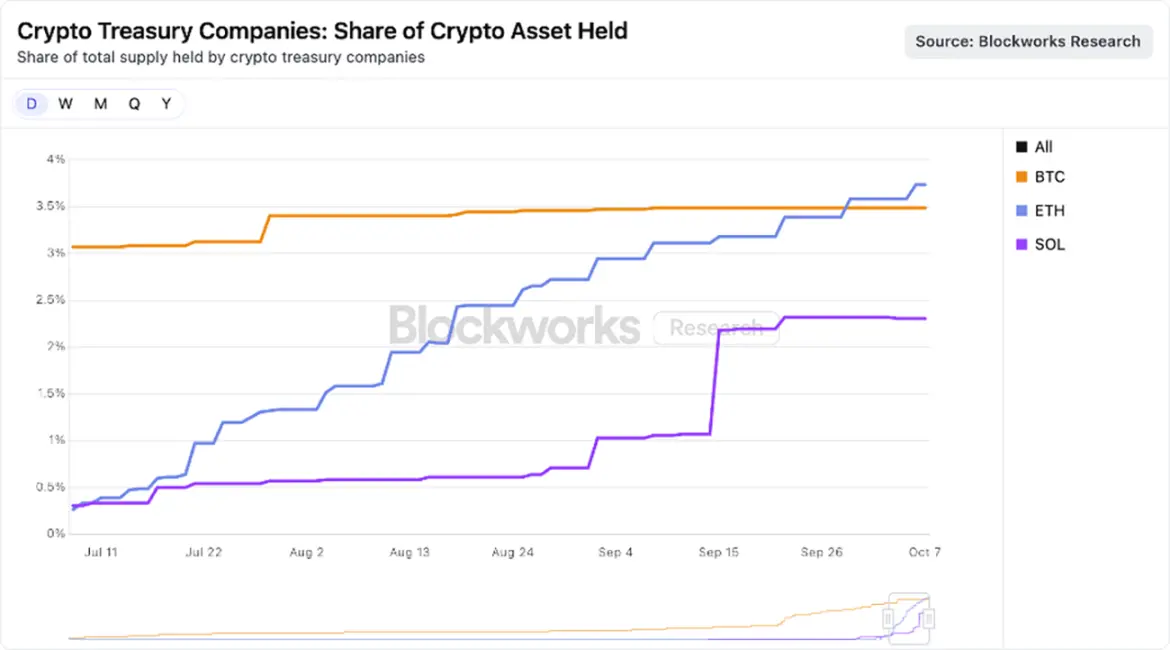Why is a crypto treasury a better solution compared to spot ETFs?
DAT's corporate structure possesses unique advantages that ETFs cannot match, which is precisely why it commands a premium over its book value.
Original Author: Lorenzo Valente
Original Translation: Chopper, Foresight News
From August to September 2025, Digital Asset Treasuries (DAT) have become the core vehicle for the mainstream adoption of crypto assets on Wall Street. This shift has likely surprised many in the industry, who originally believed that Exchange-Traded Funds (ETF) would continue to dominate, rather than being gradually replaced by DAT.
What exactly happened behind the scenes? A few years ago, Strategy was the first to launch the bitcoin DAT model, but at that time investors did not yet know how to apply it to other crypto assets. This article will delve into the market landscape and related controversies of DAT.
Definition of DAT
Digital Asset Treasuries (DAT) refer to companies that directly hold cryptocurrencies such as bitcoin, ethereum, and solana on their balance sheets, allowing investors to gain indirect exposure to crypto assets by purchasing their stocks.
Unlike spot bitcoin/ethereum ETFs regulated by the U.S. Securities and Exchange Commission (SEC), which passively hold crypto assets and issue shares pegged 1:1 to their holdings, DATs are operating companies that can manage their positions through leverage, corporate strategy, or financing tools. ETFs, as regulated public investment vehicles, provide compliant asset exposure; DATs, on the other hand, introduce corporate-level risks, and returns or losses may exceed the volatility of the underlying assets themselves.
Even before the term "Digital Asset Treasury" appeared, Strategy had already created the first bitcoin DAT. Under the leadership of Michael Saylor, the company de-emphasized its enterprise software business and focused on accumulating bitcoin. As of September 15, 2025, Strategy had purchased over 632,000 bitcoins for $46.5 billion, at an average price of $73,527 per coin. Currently, the company's bitcoin holdings account for more than 3% of bitcoin's total supply of 21 million coins.
Strategy accumulated its bitcoin holdings through various financing strategies: initially issuing convertible senior notes, then issuing senior secured notes with a coupon rate of 6.125%, and the real breakthrough came from its at-the-market (ATM) stock issuance plan. Because its stock (ticker MSTR) traded at a significant premium to book value, Saylor diluted existing shareholders by issuing new shares, using the funds raised to buy more bitcoin and increase the per-share bitcoin holding. Essentially, the funds provided by shareholders gave Strategy leveraged exposure to bitcoin.
This model has sparked widespread controversy. Critics accuse DATs of "selling $1 of assets for $2"; if a DAT's trading price is twice its market net asset value (mNAV), it means investors are paying $2 in stock price for $1 of bitcoin on the balance sheet. In their view, such a premium is neither reasonable nor sustainable.
But so far, Strategy's stock performance has disproved this judgment, delivering substantial returns to shareholders. Except for a brief discount during the bear market from March 2022 to January 2024, MSTR has long maintained a significant mNAV premium. More importantly, Saylor has strategically utilized this premium: issuing shares at prices far above book value to continuously accumulate bitcoin and realize position appreciation. The results show that since the first bitcoin purchase in August 2020, MSTR has not only enabled shareholders' bitcoin exposure to achieve compound growth, but has also significantly outperformed the simple buy-and-hold bitcoin strategy.
DAT Market Landscape
Five years after Strategy's first bitcoin purchase, hundreds of DATs have now emerged. These new vehicles are hoarding a variety of crypto assets, including ethereum, SOL, HYPE, ADA, ENA, BNB, XRP, TRON, DOGE, SUI, AVAX, and more.
The market is now beginning to concentrate on large-cap assets, with several well-funded DATs competing to accumulate ETH and SOL. As shown in the chart below, DATs focused on ETH collectively hold 3.74% of ethereum's supply, while Solana-based DATs hold 2.31% of SOL's supply.

Data source: Blockworks, as of August 25, 2025
In our view, although some DATs may have been established for short-term speculative purposes, the ultimate winners may become more efficient vehicles for crypto assets than spot ETFs. Leveraging corporate structure advantages, DATs can use leverage, corporate financing, and strategic options—capabilities that ETFs cannot achieve. As long as their mNAV premium is sustainable, these advantages will persist, and we will further explore this topic in subsequent sections.
Why is the mNAV Premium of DAT Reasonable?
As a large-scale crypto asset management company, ARK Invest has shown strong interest in the emerging DAT sector and has recently invested in the leading ethereum DAT—Bitmine Immersion. Although we remain cautious about DATs and closely monitor their rapid development, we can still understand the reasons why some DATs obtain mNAV premiums, mainly including the following points:
Income / Staking Yield
Smart contract L1 blockchains (especially ethereum) provide native yields through staking mechanisms, rewarding users who participate in network security. In the crypto asset ecosystem, this yield essentially serves as a "risk-free rate" because it is generated within the protocol and does not involve counterparty risk.
In contrast, U.S. spot ETFs are not allowed to stake their underlying assets for profit. Even if regulators change their stance, due to ethereum network design limitations, ETFs can only stake a small portion of their holdings (possibly less than 50%)—the network's "churn limit" specifies the number of validators that can join or exit per epoch. This restriction is crucial for network security, preventing malicious actors from instantly starting or shutting down large numbers of validators and avoiding consensus or state management failures, resulting in ETH staking or unstaking taking up to two weeks. Although ETFs could circumvent this restriction through liquid staking protocols, compliance, liquidity, and centralization risks may prevent them from staking large portions of their holdings.
DATs, on the other hand, have much greater operational flexibility. A typical DAT is a lean organization, often run by a small team, yet capable of generating considerable returns. For example, if Bitmine Immersion reaches a market cap of $10 billion and stakes all its ETH, it could generate about $300 million in free cash flow annually. These funds can be reallocated to mergers and acquisitions, token purchases, on-chain opportunities, or dividends.
Hoarding Speed
The speed of asset accumulation and the growth rate of crypto assets per share are important reasons for DATs to obtain book value premiums. The growth rate of crypto assets per share in a DAT may exceed the price increase of the underlying asset itself, further accelerating revenue growth through staking yields.
Take Bitmine as an example. On July 13, the company held 163,142 ETH based on approximately 56 million fully diluted shares (UTC+8); at an ETH price of $2,914 at the time, each share corresponded to 0.0029 ETH, worth $8.45. Just 31 days later, according to our estimates, Bitmine's ETH holdings increased to 1.15 million (UTC+8), and fully diluted shares rose to 173 million; at an ETH price of $4,700 at the time, each share corresponded to 0.0066 ETH, worth $32.43.
Within a month, the price of ETH rose by about 60%, while Bitmine's per-share ETH holdings grew by 130%. In other words, Bitmine, through the "ATM stock issuance + value-accretive acquisitions" arbitrage model, created value far beyond simply holding ETH.
Of course, this dynamic only holds when there is an mNAV premium and ATM issuance is value-accretive. If the premium narrows or turns into a discount, DATs will have to rely on other capital market tools, such as selling some of the underlying tokens to buy back shares.
Using the Shapley value decomposition method, Bitmine (stock code BMNR)'s stock performance can be attributed to three variables: ETH price, per-share ETH holding growth, and mNAV premium or discount changes (see chart below). As of August 25 (UTC+8), per-share ETH holding was the largest driver of BMNR's stock price and shareholder returns.

Data source: ARK Invest, as of August 25, 2025; Note: Based on Shapley average value, using only public data
Liquidity and Low-Cost Capital
Liquidity is a core reason for the DAT premium. ATM stock issuance and convertible bonds are only feasible when the stock is liquid: ATM relies on sufficient daily trading volume, requiring the DAT to continuously issue shares without depressing the stock price; convertible bonds are similar—investors are buying "bonds + conversion options," and the value of the option depends on the stock being liquid enough to sell or hedge efficiently. Illiquid instruments cannot attract investors or may result in excessively high financing costs for issuers.
Scale is also critical, as the bond market typically serves large enterprises. Investment banks and institutional lenders rely on secondary market demand, which depends on company market cap and liquidity. In fact, most syndicated loans and institutional convertible bond issuances are only available to companies with market caps over $1-2 billion. Below this threshold, financing costs rise sharply, and financing channels are usually limited to customized or venture-style credit tools. For example, Strategy was able to issue multiple rounds of convertible bonds totaling billions of dollars precisely because its stock was liquid and its market cap was in the tens of billions at the time.
Preferred stock issuance also reflects this. The structured equity transactions used by Strategy require both a strong balance sheet and secondary market liquidity to attract institutional investors; preferred stock buyers must believe they can exit or hedge their positions, and illiquid DATs cannot access this financing channel.
In short, liquidity can lower financing costs. To compensate for the risk of insufficient liquidity, investors will demand higher returns, so illiquid DATs will have to pay the price in one or more of the following ways: higher discounts on equity issuance, higher bond coupon rates, or stricter covenant terms. Conversely, liquid DATs can raise funds at lower costs to hoard bitcoin or ethereum, creating a flywheel effect that reinforces the premium.
Strategic Optionality
Many investors compare crypto assets (especially L1 tokens) to stocks, commodities, or currencies, but in reality, their differences far outweigh their similarities. DATs highlight this distinction and prove that ETFs may be inefficient as vehicles for L1 assets. The corporate structure of DATs provides "strategic optionality corresponding to book value premiums." Large DATs can acquire tokens at a discount during distress (such as FTX bankruptcy liquidation sales) or acquire other DATs trading below mNAV.
For example, Bitmine Immersion, with a market cap of $10 billion, only needs to issue 2%-3% of its shares to acquire $200 million worth of ethereum DAT at a discount, achieving value-accretive M&A. In addition to M&A, ecosystems like Solana and ethereum offer other opportunities: these networks host hundreds of billions of dollars in liquidity and applications, and DATs of sufficient scale can profit through "on-chain security maintenance" or "providing liquidity." In fact, protocol teams may offer incentives to attract well-capitalized participants to join their ecosystems.
Another arbitrage opportunity exists in the "interest rate differential between traditional markets and on-chain," which sometimes exceeds 500 basis points (i.e., 5%). In a low-interest-rate environment, DATs can borrow dollars at low cost in traditional financial markets and deploy funds in on-chain lending pools for significantly higher yields. Currently, stablecoin pools such as sUSDS, sUSDe, SyrupUSDC offer annualized yields of about 7%, about 300 basis points (3%) higher than U.S. Treasury yields, giving DATs the opportunity to earn additional income streams beyond simple token appreciation.
Risks
Although DATs provide investors with a new way to access crypto assets, they also bring significant risks that investors need to weigh carefully.
The first is reliance on market premiums. The DAT model (especially per-share crypto asset growth) depends on the stock trading price being above mNAV. When the premium narrows, the ability of DATs to create value through stock issuance will weaken or disappear, forcing them to slow down acquisitions or sell tokens to buy back shares.
Second, liquidity is a double-edged sword. While liquidity allows DATs to access low-cost capital, it can also trigger liquidity crises in down markets. In a prolonged bear market, DATs may fall into a negative feedback loop: stock prices plummet, financing costs rise, and potential redemption pressure forces token sell-offs.
Third, regulatory uncertainty is increasingly prominent. Unlike ETFs, DATs are in a regulatory gray area, and their accounting treatment, information disclosure, and other aspects may face regulatory scrutiny—these requirements are more applicable to investment funds than to operating companies. Regulatory intervention may affect their capital market financing channels or limit their strategic options.
Fourth, governance and operational risks may be underestimated. Many DATs are managed by small teams overseeing multi-billion-dollar asset pools; weak internal controls, poor risk management, or misaligned incentives can quickly erode value. In the worst case, some DATs may become "disguised aggressive on-chain hedge funds"—chasing yields, leveraging up, lacking transparency in capital allocation, leading to hidden risks or even bankruptcy.
Conclusion
The rise of DATs has provided investors with a new way to access crypto assets. From Strategy's seemingly maverick bet to now becoming a widespread phenomenon, DATs have rapidly proliferated in mainstream L1 blockchain protocols such as ethereum and solana. Although critics dismiss their model as "selling $1 assets for $2," the reality is more complex.
The corporate structure of DATs has unique potential advantages that ETFs cannot match, which is precisely why they obtain book value premiums: they can increase the value of each share of ETH or SOL at a rate faster than the price appreciation of the underlying asset; they have liquidity and scale advantages, allowing them to obtain cheap capital throughout the capital structure; and they have opportunities for M&A, token purchases, and on-chain investments.
Unlike ETFs that passively hold crypto assets, DATs are dynamic capital market vehicles with the potential to amplify asset exposure, capture protocol yields, and optimize capital allocation. For some assets, DATs may not only be more sustainable than ETFs, but also more efficient. They are by no means short-lived arbitrage tools, but may become long-term institutions connecting traditional financial markets with the new world of crypto assets.
Recommended Reading:
Bloomberg Special Report: Binance's Rival—A Deep Dive into How Hyperliquid Successfully Captured Market Share
Epic Crash! BTC Barely Holds the $100,000 Mark—Why Did the Altcoin Market Suffer a Bloodbath?
The Other Side of Binance Memecoin Frenzy: 1.4% Graduation Rate, Mega Whales Suffer Over $3.5 Million in Losses
Disclaimer: The content of this article solely reflects the author's opinion and does not represent the platform in any capacity. This article is not intended to serve as a reference for making investment decisions.
You may also like
DOJ Exposes $7.8M Crypto Scam Tied To Bitcoin Rodney

Grayscale Signals Bitcoin Could Hit New Highs in 2026 Despite Recent Dip

Will the Bitcoin Cycle Survive American Monetary Policy?

Bitcoin Price Plummets: BTC Falls Below $89,000 in Sudden Market Shift
